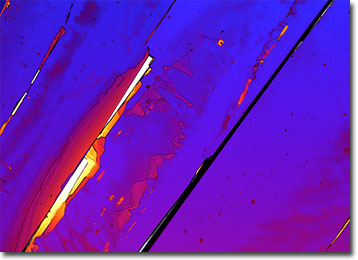Polarized Light Microscopy Digital Image Gallery
TNT (Trinitrotoluene)
Trinitrotoluene, better known as TNT, is a pale yellow, crystalline solid commonly utilized as an explosive. The well-known chemical compound, which is prepared by carefully nitrating toluene, is, however, a relatively stable material under most conditions.

In order for TNT to be utilized as an explosive, a detonator must be used because the aromatic hydrocarbon will only explode at temperatures above 240 degrees Celsius. TNT melts, however, at about 81 degrees Celsius, which makes it possible to safely melt the material and pour it into artillery shells. Also, unlike some other types of explosives, TNT does not generally explode when exposed to friction, jarring, or similar contact and does not react with metals or absorb moisture. Thus, the material can be safely stored for significant amounts of time, although it does readily react with chemical reducing agents. TNT can be absorbed by human skin, and symptoms of exposure include headache, anemia, and dermal irritation.
German chemist Joseph Wilbrand discovered TNT in 1863, but the material was not known to be an explosive until almost 30 years later. The first country to manufacture TNT was Germany, which began industrial production in the 1890s and commercial operations in 1901. By 1902, the German Army had begun utilizing TNT for filling munitions. Other countries soon followed Germany’s lead, and during World War I, TNT became the standard explosive for troops of all nations. In fact, the tremendous demand for TNT at this time resulted in a shortage of the material since its manufacture was limited by the amount of toluene available from coal tar. Many countries began utilizing TNT in mixtures with other substances during this period in order to make dwindling supplies of the important explosive last longer.
